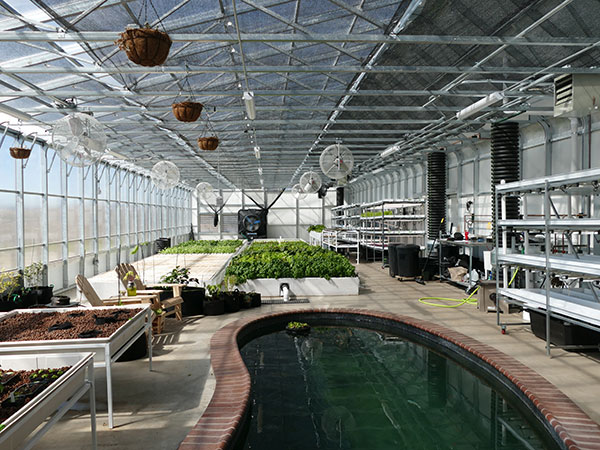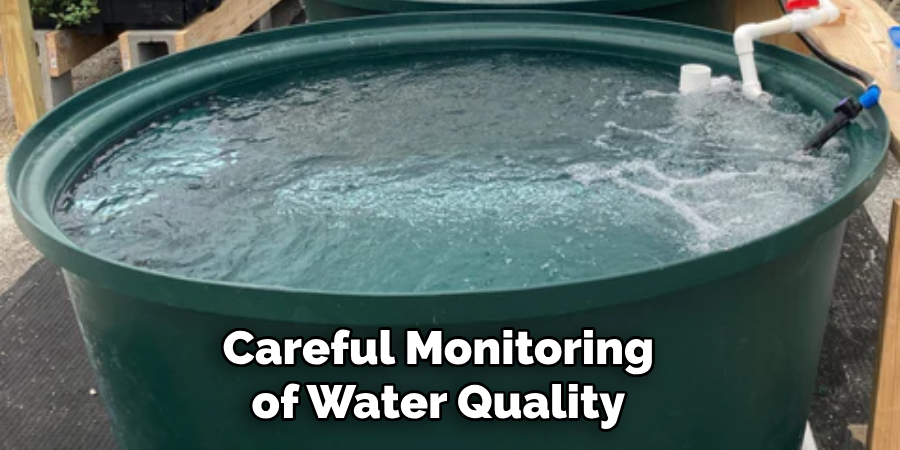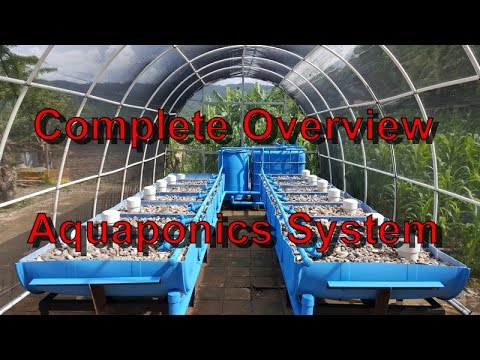To build an aquaponics greenhouse, first, construct a structure that accommodates grow beds and fish tanks, ensuring efficient temperature control, sufficient sunlight, and proper ventilation. Then, install a water supply system connecting the fish tank to the grow beds, where plants grow in a soil-less medium and absorb nutrients from fish waste.

Credit: ceresgs.com
How to Build an Aquaponics Greenhouse: Step by Step Guide
Creating The Foundation For Your Aquaponics Greenhouse
Creating the foundation for your aquaponics greenhouse involves carefully selecting the ideal location, preparing the ground, and choosing the appropriate size and design. By choosing a location that receives ample sunlight and is easily accessible for maintenance, you can optimize the growth of your plants and the productivity of your aquaponics system.
Preparing the ground involves leveling the area, removing any debris or obstacles, and ensuring proper drainage. This will create a stable and functional foundation for your greenhouse. Additionally, selecting the appropriate size and design is crucial for maximizing space, efficiency, and aesthetics.
Consider factors such as the number of plants you want to grow, the available space, and any specific climate considerations. By following these guidelines, you can build a successful aquaponics greenhouse that thrives in both function and aesthetics.
Constructing The Aquaponics System
Constructing an aquaponics system for your greenhouse involves carefully designing the components. Start by installing the grow bed and fish tank. Ensure they are properly positioned to optimize space and facilitate water flow. Next, connect the various parts of the system, such as the pipes, pump, and filtration system.
Take time to double-check that everything is securely fastened and functioning correctly. Regular maintenance and monitoring will be essential to keep your aquaponics system running smoothly. With a well-designed and properly installed setup, you’ll be able to enjoy the benefits of a sustainable and efficient aquaponics greenhouse.
Building The Greenhouse Structure
Building an aquaponics greenhouse requires careful selection of materials, constructing the frame, and installing the covering and ventilation system. The right materials are crucial to ensure the durability and efficiency of the greenhouse. When constructing the frame, it is important to choose sturdy materials that can withstand the weight of the covering and provide stability.
Additionally, the frame should be designed to accommodate the desired size and layout of the greenhouse. Once the frame is built, it’s time to install the covering and ventilation system. The covering should be made of transparent materials that allow sunlight to penetrate while protecting the plants.
Moreover, a well-designed ventilation system is essential to maintain optimal temperature, humidity, and air circulation inside the greenhouse. By following these steps, you can create a functional and sustainable aquaponics greenhouse.
Setting Up The Aquaponics Components
Setting up the aquaponics components involves the installation of the plumbing system. It is important to ensure that the pipes are properly connected and sealed to prevent leaks. Next, you need to add the grow media to the grow bed, which will serve as the medium for the plants to grow.
This can be a mixture of clay pebbles, coconut coir, or even gravel. Once the plumbing and grow bed are set up, it’s time to introduce the fish and plants to the system. Carefully select the appropriate fish species that can thrive in an aquaponics environment, and choose plants that have similar growth requirements.
This will create a harmonious ecosystem where the fish will provide nutrients for the plants, while the plants will filter and purify the water for the fish. By following these steps, you can successfully build your own aquaponics greenhouse and enjoy the benefits of sustainable and organic gardening.
Maintaining The Aquaponics Greenhouse
Maintaining the aquaponics greenhouse requires careful monitoring of water quality and nutrient levels. Regularly check the ph, ammonia, nitrate, and nitrite levels to ensure optimal conditions for the fish and plants. Keep a log of these measurements for future reference.

Regulating temperature and humidity is crucial for a successful aquaponics system. Install fans, vents, and thermometers to maintain the desired environment. Insulate the greenhouse to minimize temperature fluctuations. Troubleshoot common issues like clogged filters, algae growth, and pests invading the system.
Regularly clean and maintain the equipment to prevent any potential problems. By staying attentive to these aspects, you can create a thriving aquaponics greenhouse that yields healthy fish and abundant crops.
Harvesting And Enjoying The Fruits Of Your Labor
Building an aquaponics greenhouse is a rewarding endeavor that allows you to enjoy the fruits of your labor. Once your system is set up, you can begin harvesting the vegetables, herbs, and fruits that grow in abundance. It’s important to care for the fish in your aquaponics system, ensuring they have a healthy environment and proper nutrition.
One of the major benefits of aquaponics is its sustainable nature, as it minimizes water usage and eliminates the need for chemical fertilizers. This eco-friendly approach to gardening promotes self-sufficiency and provides you with fresh, organic produce all year round.
With a well-maintained aquaponics greenhouse, you can indulge in the joy of growing your own food while contributing to a more sustainable future.
Expanding Your Aquaponics Greenhouse
Scaling up your aquaponics system involves expanding your greenhouse to accommodate more plants and fish. By exploring different crops and species to cultivate, you can maximize productivity and diversity. Increasing your knowledge and understanding of various plants and fish will help optimize your aquaponics system.
With an expanded greenhouse, you can experiment with new techniques and learn from the results. Additionally, sharing your aquaponics knowledge with others allows you to inspire and educate fellow enthusiasts. Whether through workshops, blogs, or social media, spreading the word about the benefits of aquaponics will help create a community of like-minded individuals.
Embrace the opportunity to grow your aquaponics system and share your passion with others. Together, we can build a sustainable future.
Frequently Asked Questions For How To Build An Aquaponics Greenhouse
What Is An Aquaponics Greenhouse?
An aquaponics greenhouse is a system that combines aquaculture (the cultivation of fish or other aquatic animals) with hydroponics (the cultivation of plants in water) in a closed-loop environment. The fish waste acts as a nutrient source for the plants, while the plants filter the water for the fish.

How Does An Aquaponics Greenhouse Work?
In an aquaponics greenhouse, fish are raised in a tank where they produce waste. This waste is then broken down by bacteria into nitrates, which are used as nutrients by the plants. The plants, in turn, filter the water and return it back to the fish tank.
It’s a symbiotic relationship that allows both fish and plants to thrive.
What Are The Benefits Of Building An Aquaponics Greenhouse?
Building an aquaponics greenhouse has several benefits. Firstly, it allows for sustainable food production, as you can grow both fish and plants in the same system. Secondly, it reduces water usage, as the water is recirculated within the system. Additionally, it eliminates the need for chemical fertilizers, as the fish waste provides the necessary nutrients for the plants.
What Can I Grow In An Aquaponics Greenhouse?
You can grow a wide variety of plants in an aquaponics greenhouse, including vegetables, herbs, and even some fruits. Leafy greens like lettuce, spinach, and kale do particularly well in this system. Additionally, culinary herbs like basil and mint thrive in the nutrient-rich water.
With proper care, you can enjoy a bountiful harvest of fresh, organic produce.
Is It Difficult To Build An Aquaponics Greenhouse?
Building an aquaponics greenhouse can be a challenging task, but it is definitely achievable with the right knowledge and guidance. It requires careful planning and understanding of the aquaponics system. However, there are many resources available, including guides, tutorials, and kits, that can help simplify the process and make it more accessible for beginners.
How Much Space Is Needed For An Aquaponics Greenhouse?
The amount of space needed for an aquaponics greenhouse depends on the scale of the system you want to build. A small-scale system can be set up in as little as a few square feet, while a larger commercial system may require several thousand square feet.
It’s important to consider the space needed for the fish tanks, grow beds, and walkways when planning the layout of your greenhouse.
Conclusion
Building an aquaponics greenhouse can be a game-changer for aspiring gardeners and eco-enthusiasts. By harnessing the power of symbiotic relationships between fish and plants, you can create a sustainable and efficient system that produces both fresh produce and clean fish.
With careful planning and attention to detail, you can create an aquaponics greenhouse that not only looks beautiful but also functions seamlessly. Remember to choose the right materials, properly size your greenhouse, and ensure a balance between your fish and plants.
Regular maintenance and monitoring will be essential to keep the system running smoothly. As you embark on this exciting venture, don’t forget to document your progress and share your knowledge with others. By building an aquaponics greenhouse, you can contribute to a more sustainable future while enjoying the benefits of fresh, homegrown food!

